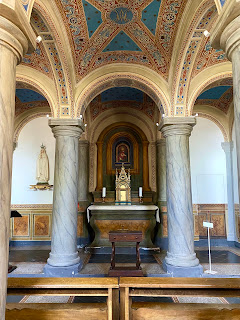 |
| San Francesco (Matteo Carboni) |
The church captured my attention because it was the opposite of many of the churches in Rome. Many churches had been touched by the Baroque period. There are many beautiful examples of Baroque architecture, decorations, and paintings in Roman churches. There are not many churches that have the wooden roof, for example.
As I walked farther into the church I noticed an open door beside the altar that led to a side chapel. The side chapel was stunning! The ceiling was painted with gold and vibrant blue. I struggled to wrap my head around the notion that a simple church could have a side chapel so ornate and bold and beautiful, complete with marble columns.
 |
| Chapel of San Francesco (Matteo Carboni) |
It is only when we sit with another person and listen to them, hear their stories about life, do we learn about those colorful and bold parts of them.
I loved San Francesco because it surprised me in so many ways. I did not expect to find a humble church in Pienza. Once I did, I did not expect to find an ornately decorated chapel tucked away, off to the side. The church reminded me to not walk through the world as if I know it (especially in areas of the world I have never walked). It reminded me to always listen to the person beside or the rhythms of the city, and be ready for the ornate, bold, and beautiful surprises that are waiting for us around the corner.
Comments
Post a Comment